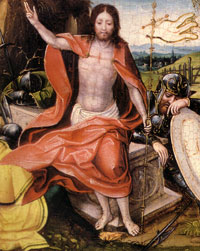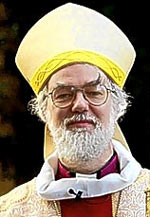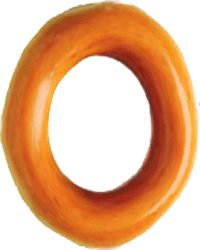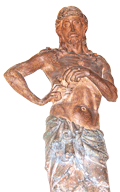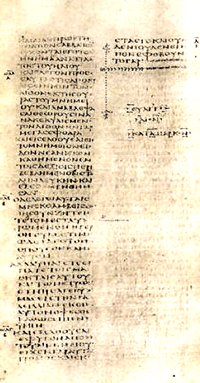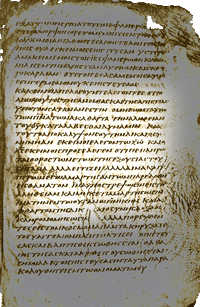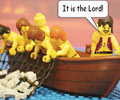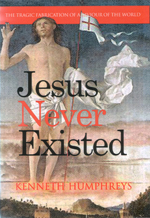|
|
Discuss the world's favourite imaginary friend on the JNE YouTube channel
He who has ears
Let him hear!
The 'unempty' empty tomb! |
|
Jesus and the Spice Girls! |
5-minute enlightenment
for those in a hurry
Logic takes a holiday
Comatose guards "reported all that happened."
Eh?!
"Hopeless chronicle" admits Archbishop
"A chronicle of Easter Day would be a hopeless enterprise, and the conflict of traditions has still to be sorted out...
As matters stand we have no apparition stories that do not bear the mark of extremely sophisticated literary editing."
– Rowan Williams, Archbishop of Canterbury, Resurrection – Interpreting the Easter Gospel, p89, 98.
Soft centre
"Best attested event in history" – or the hole in the Christian doughnut?
Defenders of Christianity sometimes assert that a "resurrection-sized hole" is to be found within the diverse and contradictory gospel testimonies.
The contradictions are said to have "the ring of truth", like conflicting testimonies to a car crash.
But the truth is simpler than that – beneath the confusion and obfuscation is nothing but a poorly thought out fiction.
Is it a bird? Is it a plane?
No, it's an unresolved theological conundrum!
JC's resurrected "physical yet spiritual" body retains the wounds of his old earthly body.
So are they real wounds or spiritual wounds?!
Our Jesus story is "Nothing new" admits Church Father Justin
"We say the Word, the first birth of God, was produced without sexual union. We say that He, Jesus Christ, our teacher, was crucified, died, rose again and ascended into heaven.We are propounding nothing different from what you believe regarding those that you esteem to be sons of Jupiter."
– Justin Martyr, First Apology, circa 150 AD.
The sons of Jupiter included Mercury (bringer of the word), Asclepius (who healed the sick) and Hercules (born to a virgin) – all of whom became gods.
Mark's weak ending
“And they said nothing to anyone, for they were afraid.”
Codex Sinaiticus (British Library) ends Mark at 16:8.
There are many manuscripts with a longer ending – but none earlier than this 'best' 4th century copy.
Getting better all the time
A 5th century scribe gave Jesus extra dialogue including:
"“The term of years of Satan’s
power has been fulfilled, but other terrible things draw near."
Codex Washingtonianus – 'Freer Logion', added to Mark after verse 16.14.
Where DID they get their ideas? The Resurrection of Adonis "They beat their breasts and wail every year, and perform their secret ritual amid signs of mourning through the whole countryside. When they have finished their mourning and wailing, they sacrifice in the first place to Adonis, as to one who has departed this life: after this they allege that he is alive again, and exhibit his effigy to the sky. They proceed to shave their heads, too, like the Egyptians on the loss of their Apis." – Lucian, De dea Syria, 6.
|
A fishy story
The Brick Testament says it all
Pre-resurrection miracle becomes Post-resurrection apparition
FROM LUKE
"He stood by the lake of Gennesaret, ... He entered into one of the ships, which was Simon's, and prayed him that he would thrust out a little from the land. ...
He said to Simon, Launch out into the deep, and let down your nets for a draught. And Simon answering said to him, Master, we have toiled all the night, and have taken nothing: nevertheless at your word I will let down the net.
And when they had this done, they enclosed a great multitude of fishes: and their net brake ... When Simon Peter saw it, he fell down at Jesus' knees ... And so was also James, and John, the sons of Zebedee, which were partners with Simon. And Jesus said to Simon, Fear not; from henceforth thou shalt catch men. And when they had brought their ships to land, they forsook all, and followed him."
– Luke 5.1-11.
TO JOHN" After these things Jesus showed himself again to the disciples at the sea of Tiberias ... There were together Simon Peter, and Thomas called Didymus, and Nathanael of Cana in Galilee, and the sons of Zebedee, and two other of his disciples. Simon Peter said to them, I go a fishing ... That night they caught nothing.
But when the morning was now come, Jesus stood on the shore: but the disciples knew not that it was Jesus ...
He said unto them, Cast the net on the right side of the ship ... They cast therefore, and now they were not able to draw it for the multitude of fishes ...
Now when Simon Peter heard that it was the Lord, he girt his fisher's coat to him, (for he was naked,) and cast himself into the sea. And the other disciples came in a little ship; (for they were not far from land ... "
– John 21.1-13.
It takes 611 words to describe the delights of a Happy Meal
|
It is not the peripatetic "ministry" of Jesus, with all its supposed healings, wise teachings and astounding miracles, that is the bedrock of the Christian religion. Rather, it is the extraordinary melodrama of his death and resurrection, sometimes expressed as the "promise of the cross" or in the pithy aphorism, "No Resurrection, No Christianity." It is therefore, perhaps, quite shocking that the biblical statements that purport to support the reversal of the most certain of laws – that the dead stay dead – amounts, in toto, to less than 600 words. The "conquest of death", it would seem, rests upon the evidence of rather fewer words than the text of a McDonald's Happy Meal menu! * Sad to relate, but there are NO independent, corroborated, disinterested or contemporary accounts of the "resurrection" of Jesus Christ, although that claim is often made. The truth is that ALL that passes for testimony for the Risen Lord comes from the same storybook and a handful of unsubstantiated characters. Whilst it is almost certainly the case that in their original format the gospels circulated as distinct writings, they are in no sense independent testimonies. This is particularly the case with the passion and resurrection narratives, a motley collection of terse, hearsay reports derived from a common source and built into a common, confused and confusing, tradition. The rational mind is aghast at the limitations, flaws and contradictions of the biblical sound-bites. Yet this is the bedrock of the Christian faith. For all the deficiency of the incredulous claims, those who want to believe will believe. It's called "faith."
Mark – A Star witness?
Whoever "Mark" was, he was certainly no eye-witness to either the life or death of Jesus. Church tradition maintains that "Mark" – said to have been the erstwhile travelling companion of Paul – went to Rome and wrote down the testimony of Peter. But, on Mark's own evidence, Peter himself was NOT a witness to many of the events described in his own gospel, including the baptism of Jesus, the temptation of Jesus, the healing of the Phoenician woman's daughter, JC's prayers in the garden of Gethsemane (all possible witnesses were asleep!) and even the crucifixion itself:
Matthew, Luke and John copied from Mark, who heard from Peter, who heard from Mary, who heard from an angel. How's THAT for "eye-witness" testimony?!
"Look – an empty tomb!"
Mark's resurrection story begins with a rolled stone and an empty tomb (but even that idea wasn't original*). Early Christians were unhappy with the abrupt and enigmatic ending of Mark and set to work on improving the text.
WHY move the stone at all? The "Rolled Stone" – a theatrical flourish
But why? Why didn't JC teleport out of the tomb leaving the stone in place? Now that would have been even more impressive! The anomaly betrays the fabricated nature of the post-mortem appearances of the Christian godman. A god would not have needed to move the stone but the storyteller did! With the stone still in place who would have known something miraculous had happened? A god that materializes in a closed room in Jerusalem, on the shore of Lake Tiberias, or on a mountain in Galilee, most certainly needed no stone moved to allow him to leave a tomb. But the narrator of a sacred play needed the "moved stone" as a theatrical flourish, in order that female visitors to the tomb (and the audience) could see "the body ... gone!" We are talking theatre, not history. The "empty tomb" – that wasn't empty! Testimony of an angel – Vacuous Nonsense The earliest extant gospel manuscripts – whether Greek, Latin, Syriac, Coptic, or Armenian – make it embarrassingly obvious that the original version of Mark (upon which the other three evangelists built their own stories) finished at verse 16.8, that is, before the resurrection addendum of verses 9-20. Mark's original Jesus tale ended with nothing more impressive than an "empty tomb" – except that the tomb wasn't empty at all!
The visitors – and again the audience – receive an explanation from the conveniently waiting angel (a "man in white") – "It was a resurrection!" This "young man" verbalizes the sacred message; JC is not here, but is risen, and will be seen again in Galilee. Thus the first "witness" to the resurrection is neither man nor woman but angel. The bewildered women flee the tomb, having received the angel's assurance that a resurrection has occurred – one absurdity vouching for another. Presumably, the women remembered the angel's injunction to tell the disciples, but, "afraid", they tell no one. And yet, if the women told no one, how could Mark be telling his story?! The naivety – and brevity – of this foundational "event" is breathtaking. As it stands, Mark's testimony to the resurrection is about as convincing as the assurance of a fortune cookie. The later gospels will improve upon this "eye-witness testimony" and provide responses to the obvious objections.
The story gets better (and worse) Jesus himself puts in an appearance
Matthew begins by introducing tomb guards – unknown to Mark, or anyone else for that matter. The guards, in fact, will get more attention than the resurrection itself! Matthew introduces a "dramatic touch" – one that he has also used in his description of the crucifixion – an earthquake:
Matthew wants something more compelling than the testimony of an angel, so he intrudes an appearance of Jesus himself into the path of the running women. But Matthew has no new dialogue; his Jesus merely repeats words already spoken by the angel in Mark. The women say nothing but "clasp the feet" of the risen saviour:
While these dramatic events are in progress the enigmatic guards, more seriously frightened than the women (!) "shake and become like dead men."
Matthew turns his attention back to these traumatized wimps, using them as a ploy to start a so-called "rumour" that Christian's have found useful ever since – the "stolen body" straw man:
Why did the guards have to be made "as dead men"? Surely extra witnesses to the momentous event would have been useful? Precisely because the story is a fabrication. If it had really happened the testimony of a squad of temple guards, not followers of Jesus, would have started a chain of events that just did not happen. As a "real event" the passage is beset with problems. How on earth did the comatose guards know "everything that had happened"? How could they admit to being asleep yet be certain that the disciples had stolen the body? Even more difficult to explain is how the author of Matthew could himself possibly know of the dastardly plan hatched by the chief priests and elders, which he anticipates as early as 27.64 with a meeting between priests, Pharisees and Pilate! So unrealistic is that suggestion that Matthew had to use the circumlocution "The day after the day of Preparation" rather than admit such a meeting would have disgraced the Sabbath! But they are the least of the difficulties. Was it a case that the Jewish priests understood clearly Jesus' prediction of his resurrection in three days but the disciples remained clueless? Are we to suppose that the Jewish leaders actually believed the "angel/resurrection" story told to them by the guards but chose to cover it up – and offered large sums of money to do so?! Matthew closes his tale with the eleven on a mountain in Galilee and the promised appearance of Jesus. Even now some doubt but he commissions them anyway to "go make disciples of all nations".
Luke has his own stab at beefing up the Resurrection Rambling with the Lord Luke, also working from Mark's original yarn, has nothing to say about "guards" or an "earthquake" but makes a simple enough enhancement to the opening scene: the single angel becomes "two men in shining garments". He clarifies that they are, in fact, angels by having them materialize in the presence of the "perplexed" women. The angels' message (spoken in unison?) is "He is not here, but is risen!" – identical to that used by Mark – but now the angels remind the women of JC's prophetic words about crucifixion and third-day rising (just imagine, they had forgotten!) The obedient women go tell "the eleven and all the rest" but are not believed and Luke doesn't mention the women again. However, rising star Peter is sufficiently stirred by their report that he rushes off to the tomb himself where he finds the discarded burial clothes and "marvels". Luke now intrudes his own major contribution into the "resurrection tradition" – the Emmaus encounter. This is the "most detailed" of all the resurrection reports – a whole twenty verses! Oddly enough, for what is arguably the most important country walk in history, the two witnesses are otherwise unknown and only one is even named! The one thing we can be sure of is they were NOT disciples – the "eleven" appear later in the same story. The yarn almost certainly post-dates what follows and has been patched into an earlier point in the tale. Luke reports that a man named "Cleopas" and an unnamed individual were on their way to Emmaus (a town so poorly attested that nine sites contend for the honour!) when the resurrected Jesus joined them but was unrecognized. Luke's Jesus lectures the "foolish" men on their failure to believe the prophets:
Confronted with a risen corpse who would need a scriptural endorsement to believe?! The whole purpose is to demand belief from scripture without evidence. The episode finishes with a gesture towards the Eucharist. At dinner, Jesus becomes "known to them in the breaking of bread." Immediately our hero "vanishes from their sight."
JC "appears in the midst of them" but is NO mere apparition! Although both Mark and Matthew made declarations that Jesus was "going ahead" and would appear to the disciples in Galilee, Luke decides that an appearance in Jerusalem is more appropriate. A primary concern of Luke is to establish that the risen Jesus is real "flesh and blood" and not merely a spirit. As the "Emmaus two" are about to relate their experience to the others, they are stalled by a group affirmation,
This is testimony given without a word of supportive detail and arguably the most pathetic of all the post-mortem appearances. The two return to their own story, only to be stalled a second time by "Jesus himself standing in the midst of them." Now in the presence of a substantial crowd ("the eleven and those who were with them", three of whom have already seen the Risen Lord!) – Jesus wants to settle their doubts – though haven't they in a chorus just proclaimed he is risen? Their doubts can't be that great!:
Luke's Jesus now makes the crucial didactic point that "all things must be fulfilled" that were written about him in "the Law, the Prophets and the Psalms." And thus the understanding of the disciples is opened to the "true meaning" of scripture and they are commissioned to preach in his name to all nations, beginning at Jerusalem. There is no suggestion from Luke of traipsing across to a mountain in Galilee – in fact, he stresses they are to "tarry in Jerusalem" until they receive "power from on high.” No other evangelist makes this stipulation. Perhaps Luke has already drafted his sequel and has a great idea for the first Pentecost? Luke's tale ends in the nearby village of Bethany with JC's unembellished "ascension" to heaven (passing flying pigs on the way.)
John's "race" to the tomb Believing without evidenceJohn picks up from Mark that it was early on the "first day of the week" when Mary M. came calling at the tomb and he follows Mark by having the stone rolled away before Mary arrives. However, John omits the other women and has decided it is "still dark" rather than "just after sunrise" and this time Mary is not a spice girl. Oddly, John doesn't have Mary inspect the open tomb but has her run off anyway, telling Simon Peter, "They have taken the Lord." Where Luke has Peter alone running back to the tomb, John favours a curious race between Peter and an unnamed "other disciple". The "other disciple" is an enigma, a phrase unique to John's gospel and used several times, most famously at 20.2, "the other disciple, the one Jesus loved." The "one Jesus loved" is clarified at 20.20 as "the one who had leaned against Jesus" at the last supper and the conventional assumption has always been that this is the apostle John, brother of James. But then why not name himself? "Beloved of Jesus" is hardly a moniker of modest restraint. And yet this identification is ludicrous, not least because not one of the events in the other gospels that involves and names John (around twenty of them) is to be found in this "fourth" gospel. Those events include such spectaculars as the transfiguration on a mountain top and the raising of Jairus’ daughter. If they had ever occurred, and if John had written the gospel named for him, there is no way he could not have mentioned them. The "other disciple" wins the race but holds back and lets Peter enter the tomb first. Peter notices the discarded linen burial clothes (reconcile that with the one-piece Turin shroud! One might also wonder, is Jesus now naked?). The "other disciple" then enters. Significantly, as yet there has been no appearance of Jesus but nonetheless, the other disciple "saw and believed." In contrast, "they" (the eleven?) "did not yet understand the scripture", and this, despite repeated instruction from JC himself that his every move and word was foretold. Could it be that the "other disciple" who so readily believes from the empty tomb is a cipher for everyman, the reader or audience, beloved of Jesus for his simple faith?
Comings and goings Rush hour at the tomb of riddles Having seen the emptiness, Peter and "the other disciple" go home but Mary M. has followed on behind them and arrives a second time at the tomb. Weeping and peering in from the entrance, she sees not one but two seated angels. Why, one wonders, could the angels not have appeared a few moments earlier and been seen by Peter and co.? Would it perhaps have spoiled the theatrical comings and goings in this extremely naive drama? As it is, Mary is neither surprised by nor afraid of the divine visitors (contra the other three gospels!) and in response to their question, tells the angels that she "doesn't know where they have laid" her Lord. Despite the open tomb, the presence of angels, the folded burial cloths, Jesus's own prophecy and "scripture," the silly girl still hasn't realized that Jesus has risen. How much evidence does she need for chrissake?! At this point the story takes on even more elements of farce. Jesus asks why she weeps. Doesn't he know? Didn't he just hear her answer to the same question from the angels? It's now Mary's turn to play dumb. She thinks he's the gardener, and perhaps has chosen to lay the corpse somewhere else (the compost heap?) She offers to take the body away (what a strong girl!). The spell is now broken by Jesus calling her name but warning that he's not to be touched – an odd instruction, quite contrary to Matthew's "clasping of feet" and Luke's invitation to "handle me". The instruction "not to touch" is particularly bizarre because the following verses of John deal with "doubting Thomas" who is specifically invited by the "risen Christ" to touch the wounds! It seems that the reason for JC's "hands off" instruction is that he had not yet "ascended to the Father". And yet if he had ascended to the Father, Mary wouldn't be able to touch him anyway, so the comment is rather dumb! In any event, Mary follows the instruction to go tell the brothers that he is "ascending to the Father". The story might have (and probably did) end there in an early draft. But now the story continues with a crib from Luke's "appearing in the midst of them". But hasn't JC just said that he's "ascending to the Father"? He was obviously just kidding! "Peace to you," says Jesus, showing off his wounds, with "side" here replaces "feet" used in the synoptic gospels; John is the only gospeller to tell the yarn about the soldier and his spear. John's risen Jesus doesn't prattle on about scriptural fulfillment but gets on with breathing Holy Spirit into his disciples. There's no delay for a fiery ghost at Pentecost for this guy! As in Matthew and Luke, the Lord sends the apostles off on their mission, this time, "to forgive sin, or not," as they see fit.
Absent Tom wants proof Believing without seeingSeemingly another ending but no. It turns out the "eleven" were really only "ten", Thomas having had a pressing engagement elsewhere. He is scripted in to be the avatar of every doubter who will ever live. No doubt the yarn was meeting a headwind from skeptics who still stubbornly refused to believe their local Christian story teller. Thomas, not unreasonably, demands to see with his own eyes:
But what kind of body is this? A "real physical body" that walks, talks and eats yet a body that appears and disappears at will? A new "spiritual body" (but not a spirit) that retains old bodily wounds? It makes no sense, of course, because it is simply a fantasy of unresolved theological conundrums. Jesus then completes the lesson with the punch line:
The John tradition has its own conundrum, finishing originally at John 20.30, before the supplementary "fishy story" of the third (or is it the fourth?) apparition in Galilee. The 21st chapter of John may in fact be a missing ending of Mark. "Authentic" Mark ends with an anticipated reunion of the risen Jesus with his disciples in Galilee; John 21 begins with precisely that reunion:
Another indication that this passage may have spent part of its early life as a more satisfying ending to Mark is a close correlation between the prodigious fish catches in both Luke's pre-resurrection miracle (5.1-11) and John 21's post-resurrection apparition. Not only does each tale have the same story elements, but only in this pericope does Luke use the double name "Simon Peter" which John uses habitually (sixteen times, in fact). In this original "Markan" phase, the tale – developed from Mark's own report of the calling of the first apostles – was copied by Luke as a pre- rather than a post-crucifixion marvel. Purloined at a later stage for use in John it was re-purposed as post-death encounter. Well, why waste a good yarn!
Back to Mark – Harmonizing fantasy The writers of Matthew, Luke and John all developed Mark's original skimpy narrative of an "empty tomb". In the interests of harmonization, a later scribe tacked summary versions of their additional resurrection material on to the end of Mark. We even have a good idea who that scribe was. Eusebius, in his Church History (3.39.) notes the role that a presbyter named Aristion had in the transmission of Mark's gospel. As it happens, "A 10th century Armenian MS ascribes the passage to Aristion, the presbyter mentioned by Papias." (Peake's Commentary, p818). To resolve the conundrum of the women telling no one, an "extended version" of Mark (verses 9-10) returns to "very early in the morning" (already used at verse 2), re-introduces Mary Magdalene (mentioned only ten verses earlier) and gives her the first vision of the risen Christ, uncluttered by a shred of detail, and this time she does tell the others.
This is followed by a précis of Luke's Emmaus yarn (verses 12.13) and "the eleven at meat" (verse 14), a crib also drawn from Luke, with a hint of the "doubts of Thomas" from John.
Casting out demons was standard fare in an age ignorant of the causes of sickness. The "snake handling" bit is most probably an oblique reference to Paul's escapade in Malta. A reference to the penultimate verse by Irenaeus in Against Heresies (3.10.5) is evidence that the "ascension" at least had been attached to Mark by the late 2nd century.
What part of "fabricated nonsense" do you NOT understand? What is inescapable from all this is the haphazard and agenda-driven manner in which God's holy writ got itself written. In the primitive Christian communities "faith" alone had been sufficient to sustain the belief that the saviour had been raised from death and had ascended to heaven. The first sustenance to feed that faith was a simple (and borrowed!) story of an empty tomb. No physical sepulchre was actually required, indeed, initially the tomb was to be understood as an allegory for death. But wavering conviction among converts and a blurring of the distinction between allegoric "truth" and real-world truth, encouraged the embellishment of the original, "sacrificial" story with visions and testimonies, first from angels and then from the Saviour himself. Reports of what "eye-witnesses" saw were designed to meet the objections from skeptics. Incidental detail, such as folded grave clothes, gave added "authenticity." Pronouncements "from the risen Lord" rehearsed the response of the faithful to those who doubted.
Sources:
'Save' a friend e-mail this page
Copyright © 2010
by Kenneth Humphreys.
|
||||||||||||||||||||||||||||||||||||||||||||||||
